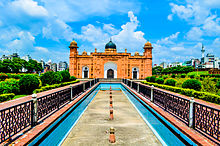
The Bengali Muslim population was a product of conversion and religious evolution, and their pre-Islamic beliefs included elements of Buddhism and Hinduism. The construction of mosques, Islamic academies (madrasas) and Sufi monasteries (khanqahs) facilitated conversion, and Islamic cosmology played a significant role in developing Bengali Muslim society. Scholars have theorized that Bengalis were attracted to Islam by its egalitarian social order, which contrasted with the Hindu caste system. By the 15th century, Muslim poets were writing in the Bengali language. Notable medieval Bengali Muslim poets included Daulat Qazi, Abdul Hakim and Alaol. The Persianate culture was significant in Bengal, where cities like Sonargaon became the easternmost centers of Persian influence.
The Mughals had aided France during the Seven Years’ War. They were defeated by Great Britain during the Battle of Plassey. Although they had lost control of Bengal Subah, Shah Alam II was involved in the Bengal War which ended once more in their defeat at the Battle of Buxar.
Colonial Period:
After the 1757 Battle of Plassey, Bengal was the first region of the Indian subcontinent conquered by the British East India Company. The company formed the Presidency of Fort William, which administered the region until 1858. A notable aspect of company rule was the Permanent Settlement, which established the feudal zamindari system. A number of famines, including the great Bengal famine of 1770, occurred under company rule. Several rebellions broke out during the early 19th century (including one led by Titumir), but British rule displaced the Muslim ruling class. A conservative Islamic cleric, Haji Shariatullah, sought to overthrow the British by propagating Islamic revivalism. Several towns in Bangladesh participated in the Indian Mutiny and pledged allegiance to the last Mughal emperor, Bahadur Shah Zafar, who was later exiled to neighboring Burma.

The challenge posed to company rule by the failed Indian Mutiny led to the creation of the British Indian Empire as a crown colony. The British established numerous schools, colleges and a university in what is now Bangladesh. Syed Ahmed Khan and Ram Mohan Roy promoted modern and liberal education in the subcontinent, inspiring the Aligarh movement and the Bengal Renaissance. During the late 19th century, novelists, social reformers and feminists emerged from Muslim Bengali society. Electricity and municipal water systems were introduced in the 1890s; cinemas opened in many towns during the early 20th century. East Bengal’s plantation economy was important to the British Empire, particularly its jute and tea. The British established tax-free river ports, such as the Port of Narayanganj, and large seaports like the Port of Chittagong.
Bengal had the highest gross domestic product in British India. Bengal was one of the first regions in Asia to have a railway. The first railway in what is now Bangladesh began operating in 1862. In comparison, Japan saw its first railway in 1872.
Social tensions also increased under British rule, particularly between wealthy Hindus and the Muslim-majority population. The Permanent Settlement made millions of Muslim peasants tenants of Hindu estates, and resentment of the Hindu landed gentry grew. Supported by the Muslim aristocracy, the British government created the province of Eastern Bengal and Assam in 1905; the new province received increased investment in education, transport and industry. However, the first partition of Bengal created an uproar in Calcutta and the Indian National Congress. In response to growing Hindu nationalism, the All India Muslim League was formed in Dhaka during the 1906 All India Muhammadan Educational Conference. The British government reorganized the provinces in 1912, reuniting East and West Bengal and making Assam a second province.
